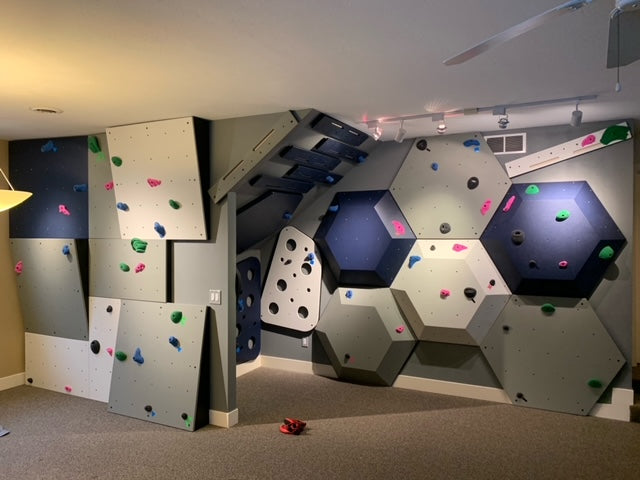Introduction to Child's Climbing Walls

Climbing walls for kids are not just a fantastic way to encourage physical activity; they're an adventure, a challenge, and a tool for growth.
With the popularity of climbing skyrocketing, more parents and educators are looking into home climbing walls as a means to support their child's development.
Benefits of Climbing Walls for Children
Physical Benefits
Climbing walls offer a dynamic physical challenge that serves as an excellent full-body workout for children, effectively enhancing their muscle strength, coordination, and flexibility. Engaging in climbing activities allows children to utilize nearly every muscle group, requiring precise hand-eye coordination and promoting significant improvements in their overall physical capabilities.
As they reach, stretch, and navigate the wall, they also develop greater agility and range of motion, making climbing an enjoyable and highly beneficial form of physical exercise for young climbers.
Cognitive Benefits
Climbing walls stimulate a child's cognitive development by fostering strategic thinking and problem-solving skills. As children plan their routes and decide on which holds to grab, they engage in a mental workout that enhances their decision-making abilities and concentration.
This activity requires them to assess situations, make quick decisions, and focus intensely on their goals, thereby sharpening their minds and preparing them for complex tasks beyond the climbing wall.
Emotional Benefits
They also offer significant emotional benefits for children by teaching persistence, boosting self-confidence, and providing the exhilarating joy of achieving goals. Through climbing, children learn to face challenges with determination, experiencing firsthand how perseverance leads to success.
This process not only builds their confidence in their own abilities but also instills a deep sense of satisfaction and happiness from reaching the top, reinforcing positive emotional development and resilience.
Types of Climbing Walls

Indoor Climbing Walls
Indoor climbing walls are a fantastic option for providing children with a safe and accessible climbing environment, regardless of the weather outside. These walls are typically found in gyms, recreation centers, and some schools, offering a variety of climbing experiences from bouldering to full-height walls equipped with harnesses and ropes.
The controlled setting of indoor climbing walls allows for adjustable difficulty levels, making it suitable for climbers of all ages and skill levels. Moreover, indoor walls are often designed with vibrant colors and themes that can stimulate a child's imagination and interest in climbing.
The main advantage of indoor climbing is its year-round availability, ensuring that children can continue to develop their climbing skills and enjoy the activity without interruption.
Outdoor Climbing Walls
While indoor walls are accessible 365 days a year, outdoor climbing walls provide a more authentic climbing experience that can be both challenging and exhilarating for children. These walls are often constructed in parks, camps, or outdoor education centers, offering climbers the chance to interact with natural elements and enjoy fresh air.
Outdoor walls can vary in design, from natural rock simulations to more structured wall designs, and they often feature a range of routes to cater to different skill levels.
Mobile Climbing Walls
Mobile climbing walls are an innovative solution for bringing the climbing experience to various events, schools, and communities without permanent climbing facilities. These portable walls can be mounted on trailers and set up in a matter of hours, providing a versatile and convenient option for festivals, school events, or community gatherings.
They offer a unique opportunity for children to try climbing in a familiar or novel setting, making climbing accessible to a broader audience.
Installing a Climbing Wall at Home
DIY vs. Professional Installation
When considering adding a climbing wall at home, weigh the options between a DIY project and hiring professionals. DIY installations can be a rewarding and cost-effective option for those with the necessary skills and confidence.
However, professional installation ensures safety, expertise, and peace of mind, especially for more complex or larger walls.
Essential Tools and Materials
Before starting the installation of a home climbing wall, it's crucial to gather all necessary tools and materials. This typically includes climbing holds, a drill, screws, plywood sheets for the wall surface, and safety mats for the landing area.
Depending on the design, you might need framing materials to create a structure for the wall.
Step-by-Step Installation Guide
Following a detailed step-by-step installation guide is vital for the successful setup of a home climbing wall.
Start by planning the wall's size and location, considering the available space and the climber's needs.
Next, build a sturdy frame and attach the plywood panels, ensuring they are securely fastened. Install the climbing holds in a variety of configurations to provide diverse climbing routes.
Finally, place safety mats or flooring to cushion falls. Each step should be approached with care to ensure the wall is safe and durable.
FAQ’s
What is the best age for children to start climbing?
Children can start engaging with climbing activities as early as 3 to 4 years old, under close supervision. This early start helps them develop fundamental motor skills, balance, and confidence. However, the complexity and height of the climbing wall should be appropriate for their age and skill level. As children grow, they can progress to more challenging climbs.
How can I ensure the climbing wall is safe?
Use high-quality materials, proper fall-attenuation flooring, conduct regular maintenance and inspections, ensure proper installation, and always supervise children while they climb.
Can climbing walls fit in small spaces?
Yes, climbing walls can be designed to fit small spaces. Modular panels and adjustable climbing holds allow customization according to the available area. For very limited spaces, a vertical or slightly inclined wall with a modest height can provide a meaningful climbing experience without requiring a large footprint.
How often should the climbing wall be inspected?
The climbing wall should undergo a thorough inspection at least once a year to ensure structural integrity and safety. However, routine checks for loose holds, damaged equipment, or other safety hazards should be conducted more frequently, ideally before each use. This helps in identifying and addressing potential risks promptly.
Are there any climbing wall options for schools?
Yes, there are several climbing wall options suitable for schools, ranging from mobile climbing walls that can be transported and set up for specific events or lessons, to permanent installations in gymnasiums or outdoor playgrounds. These walls are designed with safety and durability in mind, suitable for the heavy usage expected in school settings. Additionally, many manufacturers offer customizable designs that can be tailored to fit the available space and the school's specific needs, including educational climbing walls that incorporate learning elements into the climbing experience.



